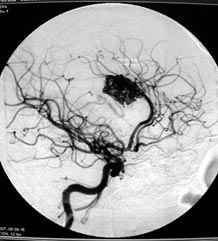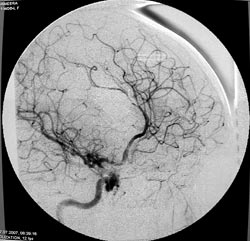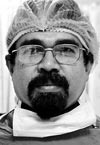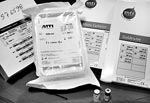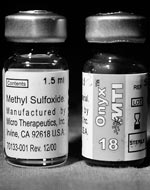
Life-saving insertion into brainLankan team creates medical history by carrying out a successful brain operation without incision She is smiling, she is talking. She wants her meals. No one seeing this 15-year-old yesterday would imagine that she has been part of a pioneering brain procedure – without actually opening up the skull – carried out at the National Hospital in Colombo on Friday.“Den mata saneepai,” says this beautiful girl from her hospital bed, explaining that she is well. Yes, it is a first for Sri Lanka and the two patients, the 15-year-old and a 39-year-old mother of two small children are recuperating after a four-hour and three-hour procedure under general anaesthesia on Friday and Thursday.
With symptoms, usually occurring in mid-life (25 to 45 years) including severe headaches, loss of consciousness, memory loss and fits or seizures, these two patients had been diagnosed as having what is medically termed ‘cerebral arteriovenous malformations’ (AVMs), a congenital condition. As with most conditions affecting the brain, the danger is sudden rupture of the artery and severe haemorrhage into the brain. And the procedure carried out was endovascular embolization of the AVM. How is this sensitive procedure which needs extreme caution on the part of the medical team, carried out without opening up the skull? “Through a puncture in the right femur (groin), we gently guide a thin catheter into the brain,” says Dr. Nihal Wijewardena, Consultant Interventional Radiologist who headed the multidisciplinary team that carried out this procedure, explaining that the catheter is as thin as a hair. Embolization involves the insertion of a catheter or tube through an artery in the groin. The tube is guided up through the blood vessels to the site of the AVM in the brain, where it delivers a liquid embolic agent that clogs up the malformation to restore normal circulation, The Sunday Times learns.
“We injected onyx into the entangled mass of vessels, the ‘nidus’, to block it off, allowing the blood flow from the affected artery to the vein to take place as it should. All the crevices of the nidus need to be filled with onyx, but the moment it reaches the vein or refluxes back to the artery, it has to be stopped for a short time. After about a minute we start again,” explains Dr. Wijewardena stressing the importance of being extremely cautious during the procedure. For the injection of the onyx the team has only 40 minutes. “We have to be careful because otherwise the onyx gets solidified and the catheter can get stuck in that. The catheter also should not strike the vein,” he explained. The team for this new procedure which has been introduced in Sri Lanka came from different disciplines. With all encouragement being given by NHSL Director Dr. Hector Weerasinghe, Dr. Wijewardena was assisted by Dr. Lakmalie Paranahewa, Dr. Sasikala Ainkaran, Dr. Manjula Gunaratne who slogged through all the background work, Radiographer Senani Wickramarachi and a dedicated team from the Radiology Department including doctors, nurses and other staffers and the anaesthetic team headed by Dr. Sriyani Hapuarachchi. “We worked in close cooperation with the neurosurgical team headed by Dr. Sunil Perera which is taking care of the post-procedural aspects as well and had the invaluable advice of Dr. Santhosh Joseph, a resource person from Chennai, India,” said Dr. Wijewardena, adding that the Medical Supplies Division willingly provided the equipment and material for this very costly exercise.
As a glimmer of hope flickers for the 80 patients diagnosed with this condition, the need of the hour is to find the funds to continue this life-saving procedure. A plea to you “Please, please take our children next,” pleads a desperate mother of a child on the waiting list, while another mother mute with sorrow makes the appeal only through her eyes. As Dr. Nihal Wijewardena assures them gently that they will be informed as soon as arrangements can be made to perform the next set of procedures, they leave with tear-filled eyes and agonized hearts. The procedure is costly. Is there anyone out there to help save a life, like that of the 15-year-old who is now full of smiles? Any kind of help, from any source such as the President’s Fund, the private sector or even the public would be precious. What is an AVM?
A vascular malformation is an abnormal collection or tangle of blood vessels which restricts or alters blood flow. In some tangles, arteries, which supply oxygen-rich blood to tissue, are interconnected with veins, which move oxygen-depleted blood back to the heart and lungs. The capillaries, the tiny vessels that deliver oxygen to cells and usually separate arteries from veins, are absent. This abnormal passage of blood is called a fistula, and malformations with such artery-to-vein connections are called arteriovenous malformations (AVMs).The treatment for AVMs, once diagnosed through angiography (which provides an image of the blood flow in the brain), could be in three forms –
Microsurgical resection of surgery on the brain for AVMs is carried out by the neurosurgeons in Sri Lanka, depending on the place they have occurred, says Dr. Wijewardena pointing out that certain parts of the brain cannot go under the scalpel because it’s too dangerous.Radiosurgery, The Sunday Times understands, is not available for patients in the country. Embolization was the procedure carried out for the first time in Sri Lanka last week, though available in countries like India.
|
|||||||||||
|| Front
Page | News | Editorial | Columns | Sports | Plus | Financial
Times | International | Mirror | TV
Times | Funday
Times || |
| |
Copyright
2007 Wijeya
Newspapers Ltd.Colombo. Sri Lanka. |
